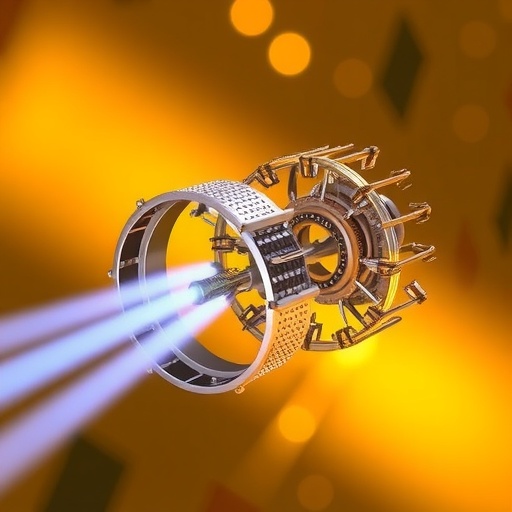The United States is witnessing a remarkable evolution in its satellite and space economy, driven by technological advancements that promise to transform our capacity for exploration and communication. The integration of sophisticated systems such as GPS, meteorological data collection, and the convenience of on-demand services underscores a fundamental dependency on these innovations. At the forefront of this transformation is the groundbreaking Rotating Detonation Engine (RDE) technology, which is poised to significantly enhance propulsion methods for the next generation of satellites.
The RDE operates under a principle that sustains a continuous detonation wave within an annular chamber, enabling it to achieve unprecedented power levels and efficiency. Traditional propulsion systems, while reliable, are limited by their design and operational parameters. The RDE, however, blazes a new trail by allowing higher thrust-to-weight ratios, leading to the potential for more compact designs that not only consume less fuel but also produce fewer emissions. This shift could revolutionize how we approach satellite launches and space travel.
Yet, this promising technology does not come without its challenges. The extreme thermomechanical conditions encountered by materials in RDE applications pose significant hurdles. The repeated, high-frequency loading associated with detonation waves requires materials that are not only strong but also resilient under intense stress. To address these challenges, a collaborative effort has emerged, underpinned by a substantial $2 million grant from the National Science Foundation (NSF).
The initiative, titled “Thriving While Detonating – Materials for Extreme Dynamic Thermomechanical Performance,” signifies a concerted effort among multiple institutions, including Lehigh University, Carnegie Mellon University, and the University of California, Irvine, to forge a path toward the development of materials specifically optimized for RDEs. The team, led by Natasha Vermaak from Lehigh University, is composed of experts from various disciplines who are pooling their knowledge to tackle the scientific mysteries associated with RDE-compatible materials.
This collaborative project captures the spirit of interdisciplinary research, marrying the realms of materials science, mechanical engineering, and advanced computing. It seeks to harness a wealth of techniques, employing not just traditional experimental methods but also modern computational approaches, including simulations and machine learning. By utilizing these advanced techniques, the team aims to develop a nuanced understanding of how materials behave under the unique stresses of RDE operation.
The RDE’s operation at such high velocities generates complex interactions between temperature, pressure, and material properties. As detonation waves traverse the engine, they introduce minute but significant fluctuations in pressure that can lead to material degradation over time. Thus, researchers must investigate how variations in materials’ microstructures, as well as their compositions, influence their performance when subjected to such taxing conditions.
Another key aspect of their research is the focus on structural materials that can withstand high-amplitude thermomechanical loads. Understanding the damage mechanisms that occur under these conditions will be critical for the advancement of RDE technology. The multidisciplinary approach aids in bridging the gap between theoretical predictions and practical applications; researchers are keen on developing materials that not only promise theoretical advantages but also perform robustly in real-world scenarios.
Moreover, the project includes collaboration with the Air Force Research Laboratory and various industry stakeholders. This connection to real-world application and development ensures that the team’s findings will not just remain within academic confines but will pave the way for tangible implementations in the aerospace sector. Such collaborations are essential for fostering innovation through the translation of research into functional applications.
With the ambition of revolutionizing propulsion systems, the insights generated from experimenting with alloy compositions and their associated performances could lead to landmark changes in how we design engines for aerospace applications. The implications extend beyond mere performance metrics, as the reduction in fuel consumption and emissions aligns with broader societal mandates for sustainability.
Understanding the relationship between RDE technology and material science is paramount, especially as the space economy continues to grow. As satellite launches become more frequent and more satellites are deployed, optimizing propulsion systems is critical not only for efficiency but for the sustainability of future missions.
Vermaak’s team is poised to make significant contributions to the academic field and industry with their research, which fits within the NSF’s broader aim to accelerate the pace of materials innovation. This initiative is a response to the Materials Genome Initiative, which seeks to decrease the time and cost associated with the development of new materials.
By addressing the technological hurdles that RDEs present, this research has the potential to redefine the standards by which future propulsion systems are judged. The team’s work is emblematic of how collaborative and interdisciplinary research can lead to more durable, efficient, and environmentally friendly technological solutions, ensuring that we not only keep up with the advancements in space technologies but stay ahead of the curve.
A successful outcome from this research could indeed propel, quite literally, the ambitions of the U.S. space economy into a new era. The convergence of high-performance materials and innovative propulsion methods promises to usher in advancements that could redefine exploration and our interactions with space.
In conclusion, the current trajectory of satellite and propulsion technology indicates a future where reliability and performance go hand in hand with sustainability. This research embodies the potential of cutting-edge science to tackle fundamental challenges and contributes to the broader narrative of human achievement in space.
Subject of Research: Rotating Detonation Engine (RDE) technology and material science for extreme conditions
Article Title: Advancements in RDE Technology: Pioneering Sustainable Space Propulsion
News Publication Date: October 2023
Web References: NSF
References: DMREF Program, Materials Genome Initiative
Image Credits: Courtesy of Lehigh University, Carnegie Mellon University, and the University of California, Irvine




